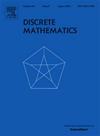On optimal placement delivery arrays
IF 0.7
3区 数学
Q2 MATHEMATICS
引用次数: 0
Abstract
A placement delivery array (PDA) is a combinatorial configuration derived from coded caching schemes which are used to reduce computer network traffics during peak usage periods. In this paper, we introduce the concept of optimal PDAs (OPDAs) as fundamental combinatorial objects and explore their key combinatorial properties. Furthermore, we present several new infinite families of OPDAs.
关于最优放置递送阵列
放置传送阵列(PDA)是一种由编码缓存方案派生的组合配置,用于减少高峰使用期间的计算机网络流量。本文引入了最优pda (OPDAs)作为基本组合对象的概念,并探讨了其关键组合性质。此外,我们还提出了几个新的无限族opda。
本文章由计算机程序翻译,如有差异,请以英文原文为准。
求助全文
约1分钟内获得全文
求助全文
来源期刊

Discrete Mathematics
数学-数学
CiteScore
1.50
自引率
12.50%
发文量
424
审稿时长
6 months
期刊介绍:
Discrete Mathematics provides a common forum for significant research in many areas of discrete mathematics and combinatorics. Among the fields covered by Discrete Mathematics are graph and hypergraph theory, enumeration, coding theory, block designs, the combinatorics of partially ordered sets, extremal set theory, matroid theory, algebraic combinatorics, discrete geometry, matrices, and discrete probability theory.
Items in the journal include research articles (Contributions or Notes, depending on length) and survey/expository articles (Perspectives). Efforts are made to process the submission of Notes (short articles) quickly. The Perspectives section features expository articles accessible to a broad audience that cast new light or present unifying points of view on well-known or insufficiently-known topics.
 求助内容:
求助内容: 应助结果提醒方式:
应助结果提醒方式:


